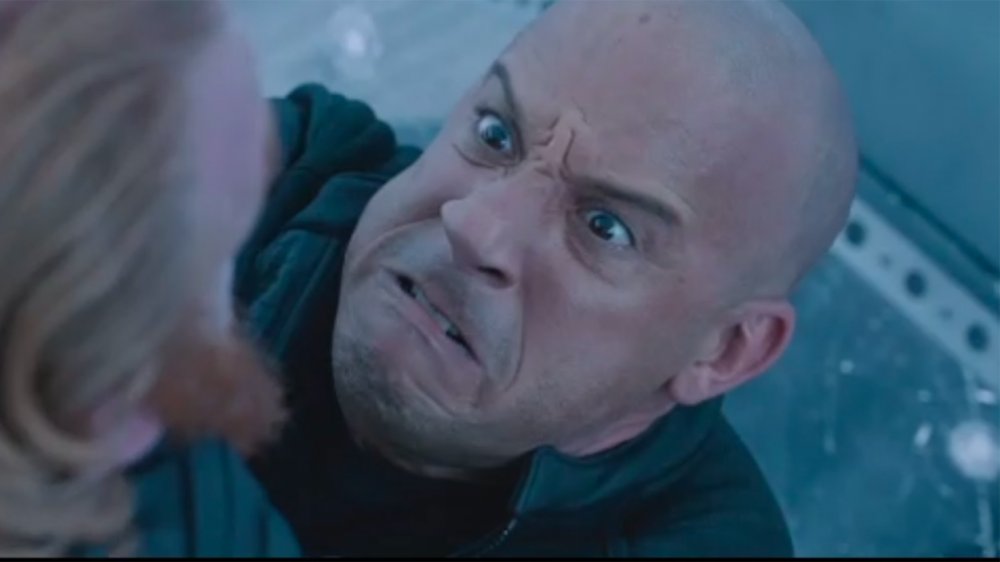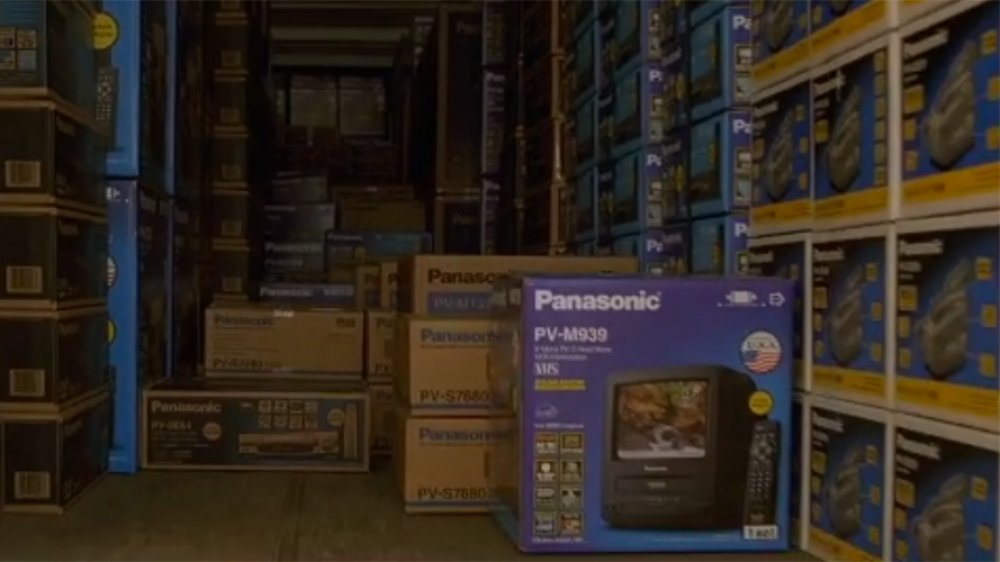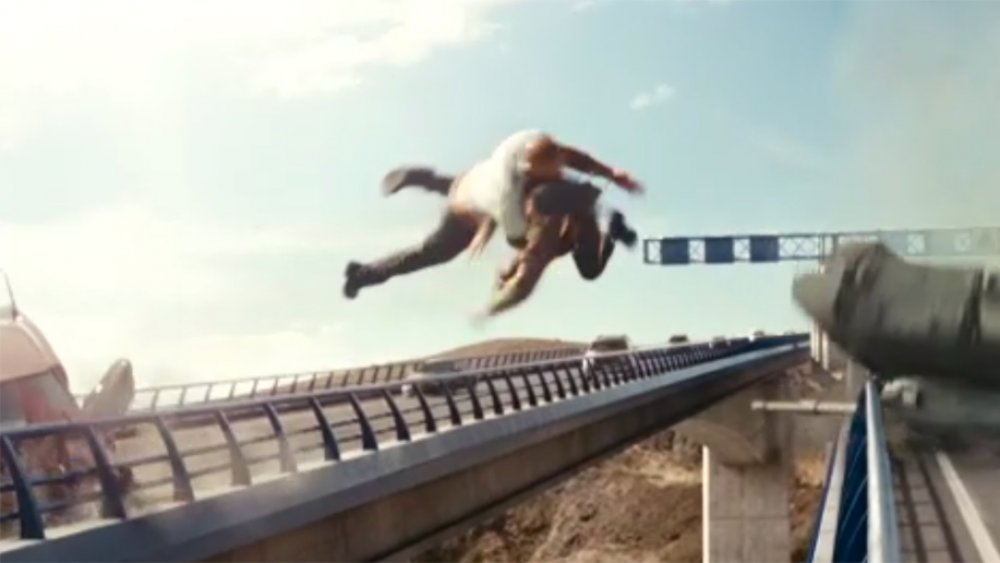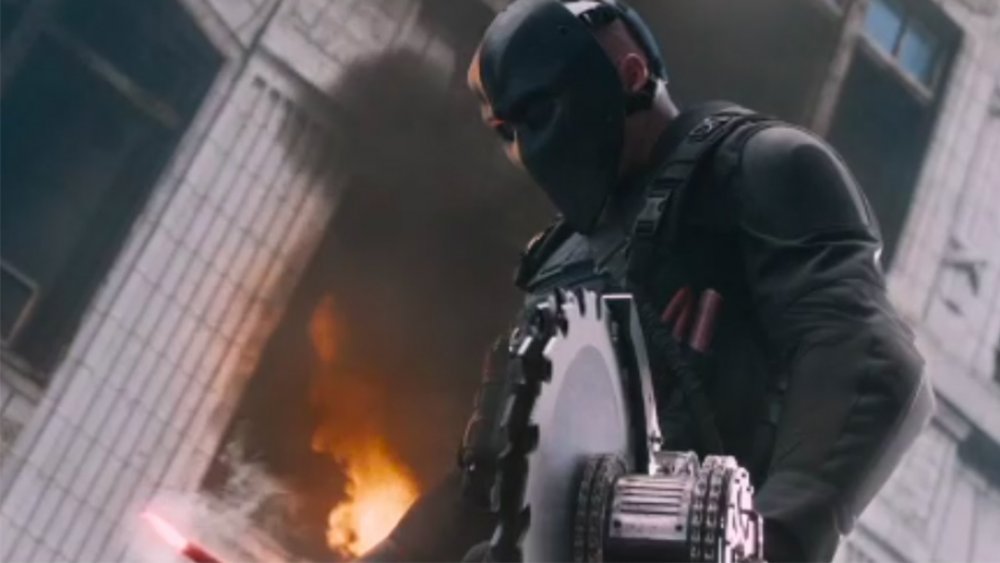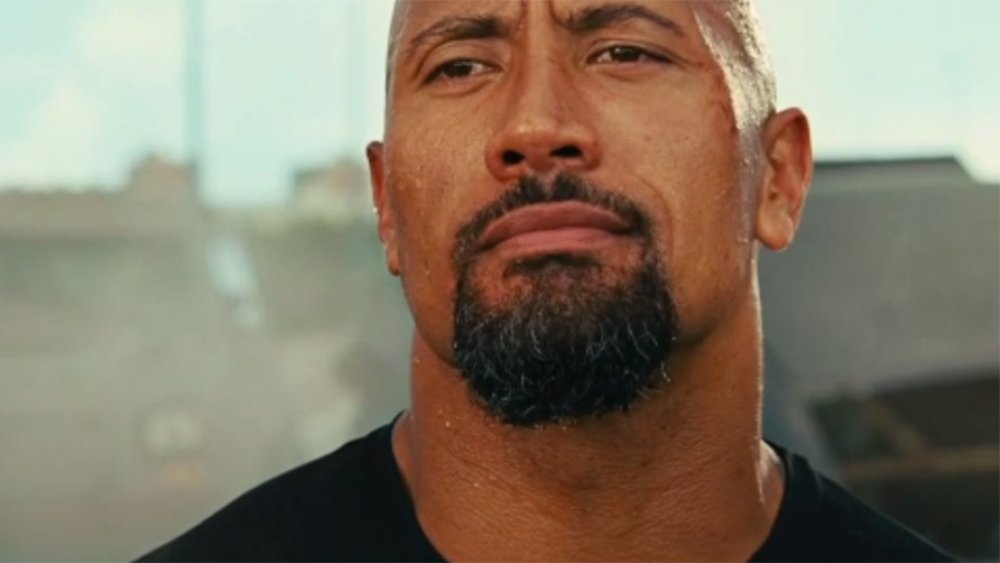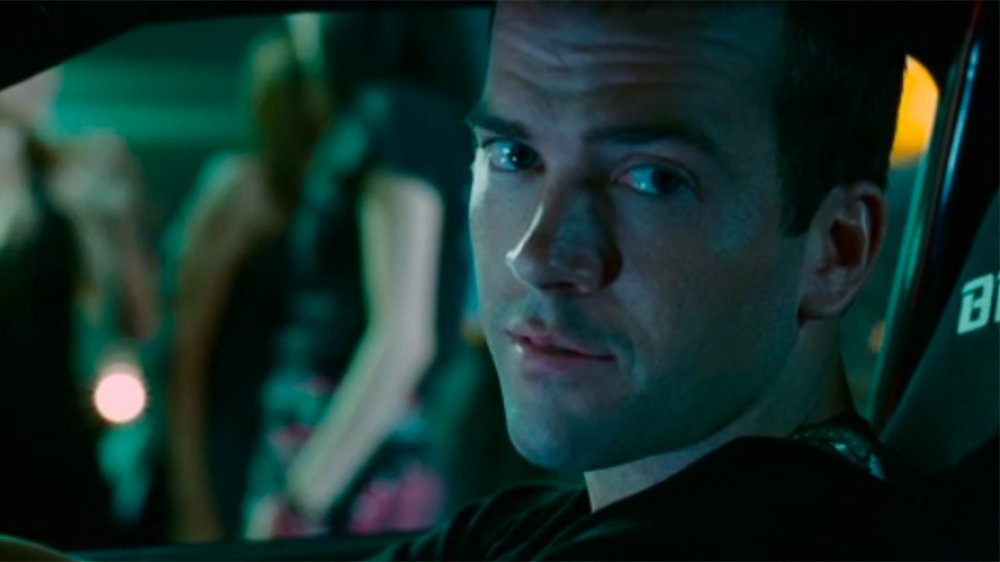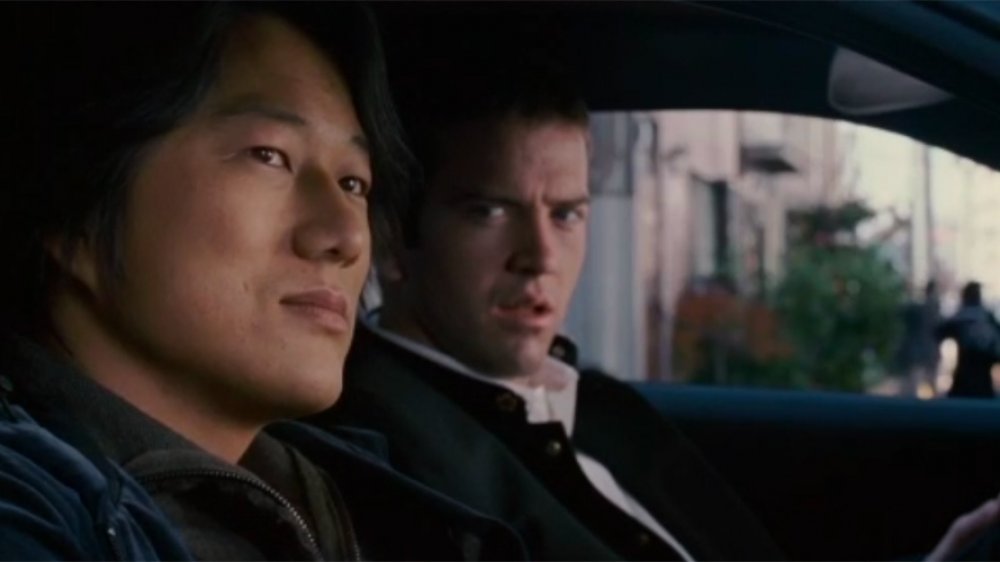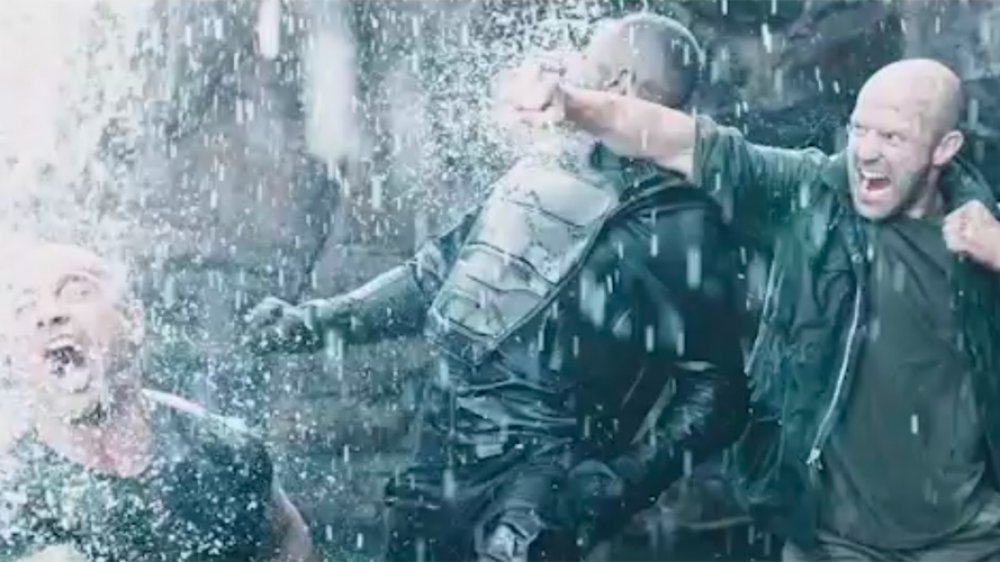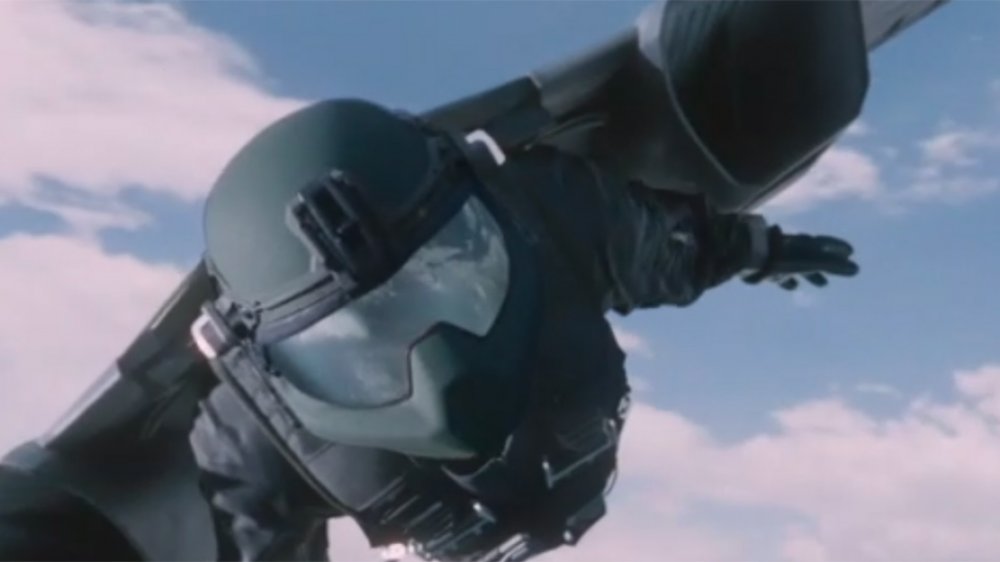Things Only Adults Notice In The Fast And Furious Franchise
The first Fast and Furious film hit theaters roughly 20 years ago, so if you're reading this, there's a chance that you literally grew up with those movies. If you did, then you're probably so used to how they work that you just think of them as a regular part of pop culture. Sure, they're a little bit over the top, and they're certainly different from other action movies, but that's just what movies are, right? The story of a group of people who found a chosen family living outside the law, and who are so good at driving muscle cars that they became the go-to strike team for a clandestine government organization's secret world-saving black ops missions. Same old, same old.
If, however, you take a moment to look back on these films — or if you're ancient enough to remember a time when action movies didn't quite work like that — you might be a little surprised to find out just how weird they are, and how they got there so gradually that you might not have even noticed. From a jaw-dropping escalation in stakes to a genre mashup that makes them more than simple action movies, here are the things that only adults notice about the Fast and Furious films.
That escalated quickly
Any franchise that lasts is bound to raise the stakes every now and then, but usually, it follows some sort of logical progression, or at least stays within the same genre. Just look at the Iron Man movies. The first film is, essentially, about building a suit of high-tech armor and stopping a bad guy from using his technology for evil purposes. Fast forward to Avengers: Endgame 11 years later, and Tony Stark is still wearing a suit of high-tech armor and using it to stop a bad guy from using technology — of a sort — for evil purposes. Bigger bad guy, weirder technology, and much more universally genocidal evil, but still basically the same sort of thing.
As it does with so many things, however, Fast and Furious defies that sort of logic. In the first film, Brian O'Conner goes undercover to take down Dom and his crew because they've stolen a truckload of consumer electronics. In Furious 7, Dom's crew is recruited to rescue the world's greatest super hacker from a mercenary warlord who retaliates by launching multiple drone strikes into the heart of Los Angeles. In the movie after that, they literally stop a full-on supervillain from holding the world hostage with stolen nuclear missiles. The spinoff has an actual cyborg super-soldier who refers to himself as "Black Superman." There are technically still cars involved in some capacity, but that's not exactly a logical progression from appliance thievery. That's barely even a logical progression for the Bond movies.
The thing is, you've probably noticed that already, and you've probably even joked about it with your friends. What you really only notice when you look back on the movies — or sit down to marathon them before the next ludicrous installment — is how suddenly it happens. The first three movies in the franchise are all about street racing. Then Fast & Furious comes along, and all of a sudden we're dealing with international super crimes. The cars aren't the only things that move fast in these movies.
The Avengers on NOS
Speaking of Iron Man, it's worth noting that the Fast & Furious movies aren't quite your traditional action flicks. They're superhero movies. That's not a metaphor either, like "Die Hard is actually a rom-com," or "Home Alone is really a horror movie." Dom and the Family might not have costumes or codenames, but Fast & Furious is a superhero franchise in the exact same way that the Avengers movies are a superhero franchise.
For one thing, there's a point in these movies where the characters just straight up get super powers, which nobody ever mentions. The best examples are probably in Furious 7, like the scene when Dom and Shaw get into a high-speed head-on collision and then get out of their cars completely unharmed so they can have a fistfight. Or when Hobbs is blown up with a grenade and falls out of a window, crushing a car, and then activates his mutant healing factor in the third act so he can flex his broken arm so hard that it shatters a cast. Or the part where Dom just full on stomps the ground and causes an entire parking structure to collapse, which is a move you usually only see from the Incredible Hulk. You can find it even earlier, though. In the opening of Fast Five, Dom snaps a pair of handcuffs with zero effort. If you were to try that yourself, you would probably find it to be exceedingly difficult for those of us who weren't sent to Earth from the dying planet Krypton. That's why the police use them so often.
It's not just the super-strength that makes these superhero movies, though. It's all of the other conventions that come along with the genre. This is a series in which people come back from the dead, and where the world is endangered by an unstoppable mastermind known only as... "Cipher." If you can't imagine villains like Owen Shaw causing problems for Spider-Man — or conversely, Dom's crew taking on Thanos and the Black Order — then you need to go back and watch 'em again.
High speed horror
You can draw a pretty direct line from Point Break to the first Fast & Furious movie, but as the franchise went on, it started pulling its influences from very different places. They've pulled in the imagery and ridiculous feats of superhero movies, the twisty structure of heist movies — especially in Fast Five — and they've even brought in some soap opera flavor with the reveals of multiple secret family members. There's one genre mashup, though, that you might not have noticed until you looked back a few years later. In Fate of the Furious, they actually pull a little bit from horror movies.
No, not the part where nuclear annihilation is hanging over everyone's head as Cipher holds the world for ransom. The real horror movie element comes from a part before that. When Cipher sends Dom to steal the nuclear launch codes from a Russian diplomat, the entire sequence is built like a horror movie. The most prominent example? Dom himself, who goes full slasher with his creepy Jason Voorhees mask and a buzzsaw that he might as well have borrowed from Leatherface.
The most glorious bit of horror style that comes in that sequence, though, happens when Cipher uses her magical action movie hacker skills to take over a bunch of cars, sending them plunging out of a parking garage and into an apocalyptic, traffic-blocking heap. In other words, she creates an unstoppable horde of shambling zombie cars. In a movie that's still largely built around street racers applying their skills to some increasingly improbable situations, the idea of everything suddenly becoming The Rolling Dead for five minutes is the best horror element that they could bring in. Well, until a Furious sequel turns out to be a crossover with Blade, at least.
DSS Jurisdiction
When you're a kid watching the action of the Fast & Furious movies, you probably have more important things to pay attention to than the minor details of a character's backstory. The explosions, for instance, tend to draw the eye more than, say, a mention that Dom used to be a professional race car driver before he turned to crime. As a result, there are a lot of details that might've gone right past you as the film moved on to more important, more flammable matters. When you do notice them, though, they're more than a little weird.
Case in point: Luke Hobbs, played since Fast Five by Dwayne "The Rock" Johnson. If you paid attention when he first showed up, you might've caught that he was part of the Diplomatic Security Service, which makes perfect sense, right? It sounds suitably governmental, so it's easy to just go along with the idea and assume that the DSS is something along the same lines as the FBI or CIA. Well, it is... and it kind of isn't.
See, here in the real world, the DSS is a division of the State Department, and while it is in fact a law enforcement agency that conducts criminal investigations, that's not really its primary focus. Rather than tracking down escaped fugitives in foreign countries, the DSS is mostly geared towards exactly what its name suggests: providing security for diplomats. They do deal with counterterrorism on occasion, but mostly with regards to threats to embassies — the organization was formed after the 1983 bombing of the embassy in Beirut. Considering that Hobbs first appears going after Dom Toretto for escaping from a low-security prison for mostly non-violent offenders, it doesn't quite fit with his remit. Besides, petty crimes are clearly the FBI's jurisdiction.
Reboot/Deboot
As a kid, you probably just assume that movies with multiple sequels are probably following some sort of plan, and to be fair, as far as F&F goes, that's probably the case now. After all, the movies had the same screenwriter from the third movie to the seventh — Chris Morgan, who also co-wrote Hobbs & Shaw with Drew Pearce — and if nothing else, he keeps tying up threads from previous movies and introducing new ones for the next film to tackle. It's all one big saga, right?
Look back on it with a grown-up's jaded eyes once you have a better idea of how the behind-the-scenes moviemaking works, and it becomes pretty clear that this wasn't always the case. The first three movies are definitely not connected in the way the later ones are, and more than anything else, it feels like there was an attempt to reboot that just did not work. Part of that comes down to star Vin Diesel. While he'd eventually become one of Hollywood's biggest franchise players thanks to F&F and Guardians of the Galaxy, there was a time when Diesel wasn't a big fan of sequels. He even turned down $25,000,000 to appear in 2 Fast 2 Furious, only returning to the franchise once he became a producer. Similarly, he didn't appear in the first sequel to xXx, and opted instead to star in The Chronicles of Riddick, which he produced.
Because of all that, the F&F films abandoned the principal cast and instead went to Japan for The Fast and the Furious: Tokyo Drift, which definitely seems like an attempt to reboot F&F as a brand for street racing movies. Needless to say, it didn't really work out, and after Tokyo Drift ended up as the lowest-grossing movie in the franchise, F&F was de-booted back to the original premise, with Diesel, Paul Walker, Jordana Brewster, and Michelle Rodriguez returning. Of course, this also completely broke the timeline, but you can't have it all.
Canon fire
When it comes to the established continuity of a long-running franchise, adults and children have a very different view on how things work. Adults tend to want things to make some kind of sense, and often find themselves obsessing over how something works. This, of course, has only exploded with the rise of the internet, leading to an entire cottage industry of explaining away goofs and picking apart cinematic "sins." Kids, on the other hand, might love memorizing details and trivia, but they also don't usually care about the stuff that defies logic.
With that in mind, here's the biggest flat tire in all of Fast & Furious's considerably complicated continuity: Han Lue, played by Sung Kang. The character first appears — sort of, we'll get back to that in a second — in Tokyo Drift, as a mentor for main character Sean Boswell. Sadly, after teaching Sean the Jedi-like secrets of drifting — "if you ain't outta control, you ain't in control" — Han is killed in a crash while racing. The thing is, Han comes back with no explanation in the fourth movie, sparking way more debate than a movie about electronics thieves out for revenge probably should've.
As a kid, you likely figured out the real reason behind Han's mysterious return: as evidenced by the presence of stuff like, say, cybernetic super soldiers, these stories aren't real. Han comes back because Sung Kang rules and director Justin Lin likes the character and the actor enough to work with him on a regular basis. That's it, mystery solved. Adults, however, have demanded the structure of classifying every movie after Tokyo Drift as a prequel if it includes Han. That solution then became increasingly problematic itself as the franchise sprawled out over the next decade, since Tokyo Drift could not look more like 2003 if it was trying. Eventually, everything was tied back at the end of Fast & Furious 6... until Han showed up again in the trailer for the ninth movie, because at this point, the franchise can no longer be contained by the bounds of death.
Complicating matters even further is that Han wasn't actually created for the Fast franchise. He's actually an import from one of Lin's earlier films, Better Luck Tomorrow, which focuses on a group of high school students driven to crime by the pressure to overachieve, and features Sung Kang playing a character named Han Lue. Both Lin and Kang have stated that F&F's Han is the same character, and that Better Luck Tomorrow is the "origin story" that explains how he ended up on the wrong side of the law, which makes that movie an actual prequel to every F&F film after the second one, including Tokyo Drift.
Making the dream work
In the main series of Fast & Furious films, the crew has mostly taken on normal human beings — or at least what passes for "normal human" in a world where someone can catch a torpedo with his bare hands. In the spinoff Hobbs & Shaw, though, they needed to come up with an antagonist that could present a believable threat to both the Rock and Jason Statham, who were playing characters that were portrayed as being so good at fighting that they could probably punch out Godzilla without breaking a sweat.
The solution was Brixton, played by Idris Elba, a literal cyborg super-soldier whose computerized brain gave him a tactical advantage that matched his bone-crushing strength. Basically, Hobbs and Shaw were fighting a Terminator who could deliver snappy one-liners. He even proves himself to be a match for them on more than one occasion, fighting them to a standstill in the middle of three square miles of explosions. Eventually, however, they discover his secret: his advanced techno-brain can only keep track of one opponent at a time. Hobbs and Shaw wind up beating him with teamwork and the power of friendship, meaning that Hobbs & Shaw essentially has the same ending as every episode of My Little Pony.
Thematically, that makes a lot of sense. As you might've picked up from the six million times they've said the word, the F&F movies are about family, and coming together to defeat an otherwise overwhelming threat — especially when it's in defense of Shaw's sister and Hobbs' entire extended family — resonates with that. On a practical level, though, it might be the dumbest thing the movies have ever done, which is saying something. Why would anyone ever design a high-tech military cyborg who could only fight one person at a time? Isn't a super-soldier like Brixton designed to be at least somewhat unique, meaning that he'd virtually always be outnumbered, taking on groups of regular soldiers who are traditionally trained to work together as a unit? "Fighting two guys" should be the first thing they figured out, not a minor concern that they'll get around to after they Idris Elba into the Matrix and give him a bulletproof leather jacket.
Jetpacks
We've already covered the superheroic elements, the improbable technology, and the delighful goofiness of remote-controlled zombie cars, but none of that can prepare you for the end of Fate of the Furious, where two dudes just cold show up flying around with jetpacks. As a kid? Awesome. As an adult? Still awesome, but also a little weird when you get right down to it.
The dudes in question are, of course, the Shaw brothers — not those Shaw bros., although the name's probably not a coincidence — who use their jetpacks to board Cipher's untraceable ghost plane and rescue Dom's secret baby in the culmination of every bit of Fast & Furious weirdness for at least three movies. The thing is, unlike the other over-the-top plot devices, the jetpacks are never once explained, or even mentioned. The God's Eye gets a long sequence devoted to it, Brixton's cybernetic enhancements have a detailed origin and consequences, but the jetpacks? Those are just there, treated as though they need about as much explanation as, say, a Honda Civic.
The thing is, these particular jetpacks bear a striking — and presumably also not coincidental — resemblance to the Falcon's wingsuit from the Captain America movies. Even in a world with gamma-powered rage monsters and literal thunder gods walking the Earth, they're considered unique enough to make their user qualify for superhero status. Owen and Deckard Shaw show up with two, and don't even bother to talk about them. They might as well just turn to the camera and say "Y'all saw Avengers, right? It's like that."
